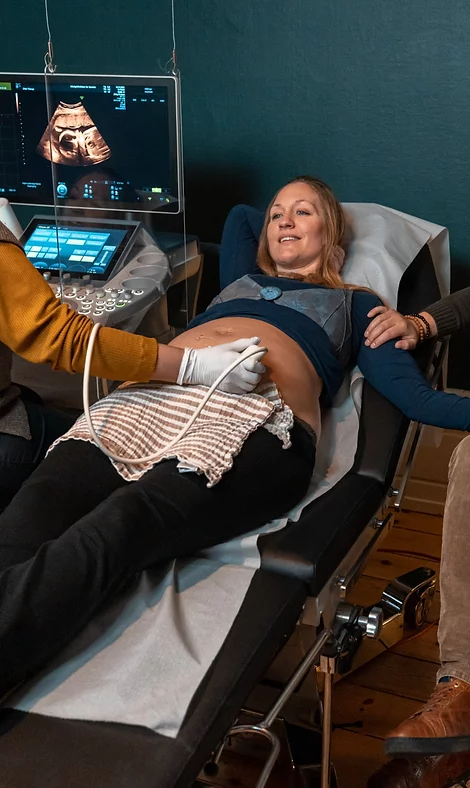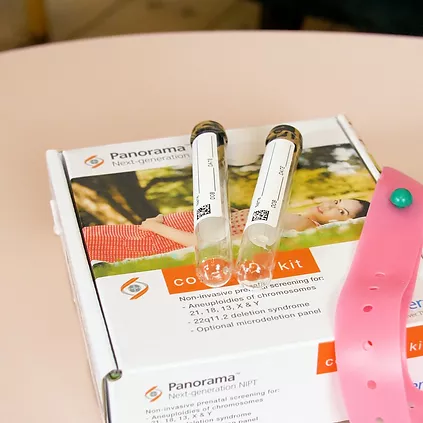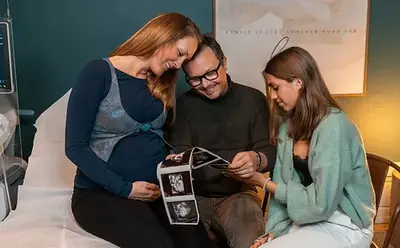
Nuchal translucency scan & double marker test
This scan is available from you’re 11 weeks and 4 days to 13 weeks and 6 days pregnant.
At this scan, we measure the fluid buildup at the back of baby’s neck (nuchal fold). Based on this measure, baby’s length, the mother’s age, and other parameters, we can determine the likelihood that your little one has Down’s Syndrome, due to an extra chromosome 21.
You have the option of adding a double marker test (blood sample) at this scan. Alternatively, you can bring the results with you if you have had this test taken elsewhere.
Duration: 30 minutes
Price, incl. double marker test: DKK 1,200
Price, excl. double marker test: DKK 1,800
The nuchal translucency scan: Understanding the ratio
The likelihood of Down Syndrome is indicated by a ratio, based on the combined results of the nuchal translucency scan and double marker test, respectively.
If between 1:10 – 1:300, the ratio is considered screen-positive, which means there is a high probability your baby has Down Syndrome. If you wish, we will inform your Ob/Gyn, as well as refer you for an amniocentesis at the right hospital. If you live in Sweden, we will refer you to Lunds University Hospital.
If above 1:300, the ratio is considered screen-negative, and we do not recommend an amniocentesis. However, if you would like additional reassurance, you might want to opt for the early anomaly scan or the Panorama test. We are happy to help you with both.
The only way to establish with absolute certainty that your baby has normal chromosomes is through amniocentesis. However, drawing tissue from your placenta is associated with a 0.5 percent risk of miscarriage. Therefore, the best and safest place to start is with the combined nuchal translucency scan and double marker test. Based on the results, we decide the proper course of action, if any. A large nuchal fold can also signify other chromosomal diseases or heart defects.
The highest level of technology on the market
We use Astraia to calculate the likelihood of Down Syndrome in your future child.
Astraia is the technology for data processing used in all Danish hospitals, and is only sold to ultrasound clinics certified by the Fetal Medicine Foundation in London.
What you receive
- Our report stating the results of your tests (which also cover ratios for trisomies 13 & 18).
- Images in black and white (printouts).
- Small video clips stored on a USB key, which can either be purchased at our clinic, or you bring yourself. We also send all pictures and videos to your email immediately following the scan.
- A small plastic folder for all documents and images you receive from us, plus any future pregnancy documents.

Book online
Visit our online booking calendar to find the time and service that best suits your needs.
Did you know?
An examination based on the nuchal translucency scan combined with the double marker test, detects approx. 90% of all fetuses with Down Syndrome.
If you want additional reassurance, we recommend a genetic screening test, e.g., Harmony, Panorama, or Evita, each of which detects 99.9% of all fetuses with Down Syndrome.
What is a double marker test?
The double marker test, also known as maternal serum screening, is a predictive test that indicates the likelihood that your little one has Down Syndrome. It is based on a blood sample, which can be taken from 9 to 13 weeks and 6 days of pregnancy.
The blood sample measures two proteins, i.e., beta-hCG and PAPP-A, both of which your baby and placenta secrete into your bloodstream. A certain concentration level of these two proteins is a telltale sign of genetic abnormality.
The double marker test as an indicator of trisomies cannot stand alone, in that only 60 percent of all babies with Down would be discovered using this method only. However, it is a great add-on to the nuchal translucency scan; combined they detect 90 percent of all babies with genetic abnormalities.
Get your double marker test results the day of your scan
There are several options when it comes to analyzing the double marker test:
We can take the blood sample on the day of your nuchal translucency scan and will send you the results via email as soon as we get them back from the laboratory.
However, if you would like to know the results on the day of your scan and are able to come in beforehand, we are happy to take the blood sample in advance. That way, we will be able to calculate the combined likelihood for Down’s Syndrome immediately following the scan.
Finally, if you’ve had the double marker test taken elsewhere, you are very welcome to bring the results to your scan.
As we are an ultrasound clinic, we do not offer to run the double marker test on its own.
However, we do look forward to thoroughly examinating your little one to establish the likelihood of Down’s Syndrome.

Different ways of detecting Down Syndrome
A placenta biopsy – Chorionic Villus Sampling (CVS) examines all baby’s chromosomes and thus detects all cases of Down Syndrome. However, it comes with a 0.5 percent risk of miscarriage.
The nuchal translucency scan detects 70 percent of prenatal Down Syndrome cases.
The double marker test detects 60 percent of prenatal Down Syndrome cases.
The two tests combined – the nuchal translucency scan and the double marker test – detect 90 percent of prenatal Down Syndrome cases.
For extra reassurance, we recommend the Panorama test or the Harmony test, both of which detect 99.9 percent of all cases of Down Syndrome.
Did you know?
Did you know that Noonan’s Syndrome is as common as Down’s Syndrome?
Noonan Syndrome is an autosomal dominant condition. Half of all cases of Noonan Syndrome newly arise in the fetus, while the other half have inherited the abnormal gene from one of the parents. Up to 80% of fetuses with Noonan Syndrome have heart defects. A nuchal translucency scan will show a large nuchal fold, which is often visible throughout the pregnancy.



